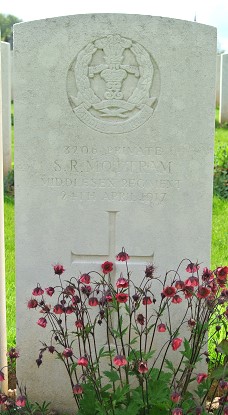Name
Samuel Roberts Mottram
Conflict
First World War
Date of Death / Age
24/04/1917
24
Rank, Service Number & Service Details
Private
PS/3206
Duke of Cambridge’s Own (Middlesex Regiment)
17th Bn.
Awards: Service Medals/Honour Awards
Not Yet Researched
Cemetery/Memorial: Name/Reference/Country
AUBIGNY COMMUNAL CEMETERY EXTENSION
II. B. 71.
France
Headstone Inscription
Not Researched
UK & Other Memorials
St Mary’s Church Memorial, Standon,
Puckeridge Memorial Plaque, Standon Village Hall, Standon
Not on the Much Hadham memorials
Biography
Samuel Roberts Mottram was a Private, No. PS/3206 in the 17th Battalion of the Middlesex Regiment (Duke of Cambridge’s Own). He was shot and mortally wounded during action and died at a Casualty Clearing Station on 24th April 1917 at the age of 24 years.
He is buried at Aubigny Communal Cemetery Extension, Aubigny-en-Artois, France. His grave reference is: II. B. 71
Additional information given by the Commonwealth War Graves Commission says that he first enlisted in the 25th Battalion in 1915, and that he was the son of Benjamin E and the late Selina Mottram of Park View Cottage, Much Hadham.
Samuel was born in 1893 and baptised at St Mary’s Church, Standon on 31st March 1893. Samuel was the youngest of seven children, with four brothers and two sisters. His middle name was taken from his mother’s maiden name, Roberts. Sadly when he was less than a year old his mother, Selina, died and was buried at St Mary’s Standon on 18th December 1893, at the age of 38 years.
Benjamin, who had been born in Buntingford, had been in the army and was stationed at Woolwich when he married Selina in 1879. In 1881 Selina and their first child, Benjamin junior were living in Woolwich presumably to be near her soldier husband in Woolwich barracks. Another 10 years on they had six children and were living in Stortford Rd, Standon and Benjamin was working as a blacksmith, which was also his father’s trade.
The loss of his wife in 1893, with seven children to look after, must have hit Benjamin very hard, but at some point between Selina’s death in 1893 and the next census in 1901 he had some help and support from his mother Ann, who was a widow, then aged 75. At that point they were living in Puckeridge High Street, somewhere near the school and chapel, with just the three youngest children at home. In 1905 Ann died and so Samuel, by then 12 years old, had lost his mother and grandmother.
On the census of 1911, Samuel is the only child living with father Benjamin, at 6 Ashton Gardens , Standon Rd Puckeridge. Samuel was then 18 years old and his occupation was as a shoemaker/repairer.
We have quite a lot of information about Samuel from his surviving Army Record. On his attestation papers dated 22nd December 1915 he gave his address as 2, White Cottage, The Parade, Enfield Wash. He was 22 yrs and 11 months old and a boot repairer.
His physical description made at the time of his medical says he was 5 ft 6 ins tall, 131 lbs in weight with a 36” – 38” chest and had a scar on the right side of his neck.
He remained in England, in training or in reserve, until embarking at Folkestone for Boulogne on 15th July 1916 as part of the British Expeditionary Force. He was initially in the 24th Battalion of the Middlesex Regiment, but was transferred to other battalions on more than one occasion as the Army attempted to fill the gaps made by the losses suffered in earlier actions. It is likely that Samuel was killed in one of several actions that together made up the Battle of Arras.
A newspaper obituary from the Herts and Essex Observer 9th June 1917 says:
“Death of Another Puckeridge Soldier: Mr B. Mottram, who has recently gone to reside at Much Hadham, has received news from the War Office that his youngest son, Pte. Samuel Robert Mottram, had died from wounds received in action. The deceased, who was 23 years of age, enlisted in the Middlesex Regiment early in 1915 and has been in France about a year. He was badly wounded in the head by shell fire on April 22nd and died two days later in the Canadian casualty clearing station. His intimate friend, Lance-Corporal Campion, who saw him carried away, wrote: “He is badly wounded in the head and I am afraid he will not live. He was a great chum of mine and we were always about together. I miss him very much.” The Rev. Donald Murray, C.F., writing to Mr Mottram, said: “You will have heard by this time of the death of your son, Pte. Mottram. He was wounded at the post of duty on the 22nd April by shell fire in the head and died shortly afterwards, after being taken to the field ambulance. I must express my sympathy with you in your loss. It is sad for those left behind, but we must remember that there is a world to come. A cross has been erected over his grave.” Pte. Mottram was a dauntless soldier and has died nobly in the Middlesex Regiement (Die Hards) which has done such splendid work in the War. Mr Mottram has two other sons in the Army and one in the Navy.”
The 17th Battalion of the Middlesex Regiment were also known as the 1st Football or Footballers Battalion, as when it was first formed, many professional footballers enlisted.
Acknowledgments
Malcolm Lennox, Di Vanderson, Jonty Wild



